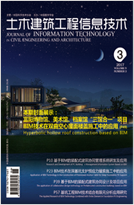2024, 16(1): 27-31. doi: 10.16670/j.cnki.cn11-5823/tu.2024.01.05
基于BIM衍生式设计的区域性建筑规划方案智能优选研究
中国矿业大学力学与土木工程学院,徐州 221000 |
Research on Intelligent Optimization of Regional Architectural Planning Schemes Based on BIM Generative Design
School of Mechanics and Civil Engineering, China University of Mining and Technology, Xuzhou 221000, China |
引用本文:
罗荃, 周建亮, 景慧情. 基于BIM衍生式设计的区域性建筑规划方案智能优选研究[J]. 土木建筑工程信息技术,
2024, 16(1): 27-31.
doi: 10.16670/j.cnki.cn11-5823/tu.2024.01.05

Citation:
Quan Luo, Jianliang Zhou, Huiqing Jing. Research on Intelligent Optimization of Regional Architectural Planning Schemes Based on BIM Generative Design[J]. Journal of Information Technologyin Civil Engineering and Architecture,
2024, 16(1): 27-31.
doi: 10.16670/j.cnki.cn11-5823/tu.2024.01.05

摘要:建筑区域性规划是对城市空间使用的设计与规制,对城市环境及其内部活动之区位的物理形态、经济功能及社会影响具有重大意义。为解决建筑区域规划普遍存在的设计师主观依赖性和效率不高的问题,本文基于BIM技术和Dynamo衍生式设计的原理,提出建筑布局规划方案设计的智能优选方法,在确定并量化设计规划方案的各类约束条件的基础上,通过多目标遗传算法,实现了多约束条件下的区域建筑布局规划方案参数化智能优选,大大提高了BIM在早期规划阶段的设计能力和工作效率,为我国建设行业更深入地挖掘BIM应用价值提供了参考和借鉴。
Abstract: Regional architectural planning is the design and regulation of the use of urban space, which is of great significance to the physical form, economic function and social impact of the urban environments and their internal activity locations. In order to solve the problems of designers' subjective dependence and low efficiency in regional architectural planning, this paper proposes an intelligent optimization method for architectural layout planning scheme design based on BIM technology and Dynamo generative design principles. On the basis of determining and quantifying various constraints of planning schemes, through multi-objective genetic algorithms, the paper realizes the parametric intelligent optimization of architectural layout planning schemes under multi-constraint conditions, greatly improving BIM design capability and work efficiency in the early planning stage. It provides a reference for the construction industry in China to further explore the application value of BIM.
| [1] | |
| [2] |
张馨元. 基于多智能体的建筑群体自动布局研究[D]. 南京大学, 2019. |
| [3] |
张柏洲, 李飚. 基于多智能体与最短路径算法的建筑空间布局初探——以住区生成设计为例[J]. 城市建筑, 2020, 17(27): 7-10+20. |
| [4] |
Nagy D, Lau D, Locke J, et al. Project Discover: An Application of Generative Design for Architectural Space Planning; proceedings of the SimAUD, F, 2017[C]. |
| [5] |
王江, 范伟, 郭道夷, 等. 基于形状语法的AutoCons可持续住区生成设计研究——以章丘岳滋新村为例[J]. 西安建筑科技大学学报(自然科学版), 2021, 53(03): 421-428. |
| [6] |
Salimzadeh N, Vahdatikhaki F, Hammad A. Parametric Modelling and Surface-specific Sensitivity Analysis of PV Module Layout on Building Skin Using BIM[J]. Energy and Buildings, 2020, 216(4): 109953. |
| [7] |
Nagy D, Villaggi L, Benjamin D. Generative Urban Design: Integrating Financial and Energy Goals for Automated Neighborhood Layout[C]// Proceedings of the Symposium on Simulation for Architecture and Urban Design, 2018. |
| [8] |
Lobo J D C, Lei Z, Liu H, et al. Building information modelling-(BIM-) based on generative design for drywall installation planning in prefabricated construction[J]. Hindawi Limited, 2021. |
| [9] |
Krish S. A practical generative design method[J]. Computer-Aided Design, 2011. |
| [10] |
Marsh A. Generative and Performative Design: A Challenging New Role for Modern Architects[J]. Design, 2008. |
| [11] |
Singh V, Gu N. Towards an integrated generative design framework[J]. Design Studies, 2012, 33(2): 185-207.doi: 10.1016/j.destud.2011.06.001 |
| [12] |
Song Y, Knaap G J. Measuring Urban Form: Is Portland Winning the War on Sprawl?[J]. Journal of the American Planning Association, 2004, 70(2): 210-25. |
计量
- PDF下载量(24)
- 文章访问量(1447)
- HTML全文浏览量(579)















